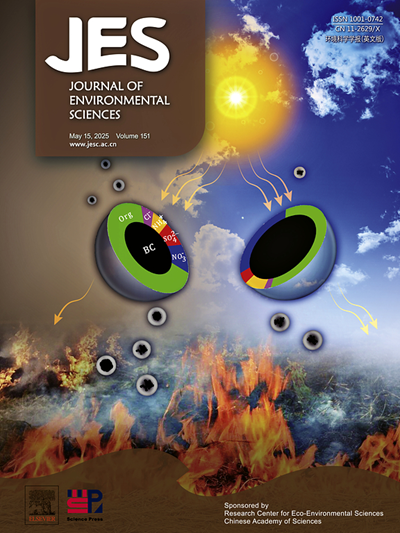来自加拿大艾伯塔省53个水体的1600多种淡水鱼样本中的砷物种。
IF 5.9
2区 环境科学与生态学
Q1 ENVIRONMENTAL SCIENCES
引用次数: 0
摘要
我们报告了1643种淡水鱼样本中的砷物种,代表了加拿大阿尔伯塔省53个水体中的14种常见鱼类。从鱼类肌肉组织中提取砷。采用阴离子交换高效液相色谱法(HPLC)分离提取液中的砷,电感耦合等离子体质谱法(ICPMS)定量分析。鱼类中总砷浓度范围为2.8 ~ 1200µg/kg(样品湿重)(平均71±101µg/kg),均低于安大略省环境部推荐的2000µg/kg(湿重)鱼类中最大允许总砷浓度。在所分析的1643份淡水鱼样品中,有1638份(99.7%)检测到砷甜菜碱(AsB),其浓度高于该方法的检测限0.25µg/kg(湿重)。在1643份淡水鱼样本中,有1514份(92.1%)检测到二甲基larsinic酸(DMA)(浓度>0.25µg/kg)。在1119条鱼(即1643份样品的68.1%)中检测到无机砷酸盐(iAsV)(>0.25µg/kg)。在418条鱼(占1643份样品的25.4%)中检测到单甲基larsonic (MMA)(>0.25µg/kg)。1643份鱼类样本中砷种类的浓度变化多达三个数量级,从低于方法检测限0.25µg/kg到AsB的最大浓度380µg/kg, DMA的最大浓度150µg/kg, iAsV的最大浓度70µg/kg, MMA的最大浓度为51µg/kg。AsB占总砷种类的46.1%±26.2%。砷的物种形成模式在湖白鱼、北梭鱼和白眼鱼这三种最常见的鱼类之间有所不同。北梭鱼中DMA的相对比例高于湖白鱼和白眼鱼,而iAsV的相对比例相反,北梭鱼中iAsV的相对比例较低。检测到7种未知砷,其色谱保留时间与现有砷标准不匹配。在1643份淡水鱼样本中,33.4%或549份样本中检测到至少一种未知的砷。未知砷种的浓度高达61µg/kg。未来的研究有必要确定未知的砷种类,并确定对观察到的砷种类模式和浓度的影响因素。本文章由计算机程序翻译,如有差异,请以英文原文为准。

Arsenic speciation in more than 1600 freshwater fish samples from fifty-three waterbodies in Alberta, Canada
We report here arsenic speciation in 1643 freshwater fish samples, representing 14 common fish species from 53 waterbodies in Alberta, Canada. Arsenic species were extracted from fish muscle tissue. Arsenic species in the extracts were separated using anion-exchange high-performance liquid chromatography (HPLC) and quantified using inductively coupled plasma mass spectrometry (ICPMS). The total arsenic concentrations in fish ranged from 2.8 to 1200 µg/kg (in wet weight of sample) (mean 71 ± 101 µg/kg), which are all below the 2000 µg/kg (wet weight) maximum allowable total arsenic in fish, recommended by the Ontario Ministry of the Environment. In 99.7%, or 1638 of all 1643 freshwater fish samples analyzed, arsenobetaine (AsB) was detectable, with concentrations higher than the method detection limit of 0.25 µg/kg (wet weight). Dimethylarsinic acid (DMA) was detectable (concentration >0.25 µg/kg) in 92.1%, or 1514 of the 1643 freshwater fish samples. Inorganic arsenate (iAsV) was detectable (>0.25 µg/kg) in 1119 fish (i.e., 68.1% of 1643 samples). Monomethylarsonic acid (MMA) was detectable (>0.25 µg/kg) in 418 fish (25.4% of 1643 samples). The concentrations of arsenic species in the 1643 fish samples varied by as much as three orders of magnitude, ranging from below the method detection limit of 0.25 µg/kg to the maximum concentrations of 380 µg/kg for AsB, 150 µg/kg for DMA, 70 µg/kg for iAsV, and 51 µg/kg for MMA. AsB made up 46.1% ± 26.2% of total arsenic species. Arsenic speciation patterns varied between lake whitefish, northern pike, and walleye, the three most common types of fish analyzed. The relative proportion of DMA in northern pike was larger than in lake whitefish and walleye, and conversely, the relative proportion of iAsV was lower in northern pike. Seven unknown arsenic species were detected, and their chromatographic retention time did not match with those of available arsenic standards. At least one unknown arsenic species was detected in 33.4%, or 549 of 1643 freshwater fish samples. The concentrations of unknown arsenic species were as high as 61 µg/kg. Future research is necessary to identify unknown arsenic species and to determine contributing factors to the observed arsenic species patterns and concentrations.
求助全文
通过发布文献求助,成功后即可免费获取论文全文。
去求助
来源期刊

Journal of Environmental Sciences-china
环境科学-环境科学
CiteScore
13.70
自引率
0.00%
发文量
6354
审稿时长
2.6 months
期刊介绍:
The Journal of Environmental Sciences is an international journal started in 1989. The journal is devoted to publish original, peer-reviewed research papers on main aspects of environmental sciences, such as environmental chemistry, environmental biology, ecology, geosciences and environmental physics. Appropriate subjects include basic and applied research on atmospheric, terrestrial and aquatic environments, pollution control and abatement technology, conservation of natural resources, environmental health and toxicology. Announcements of international environmental science meetings and other recent information are also included.
 求助内容:
求助内容: 应助结果提醒方式:
应助结果提醒方式:


